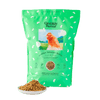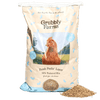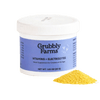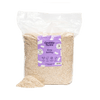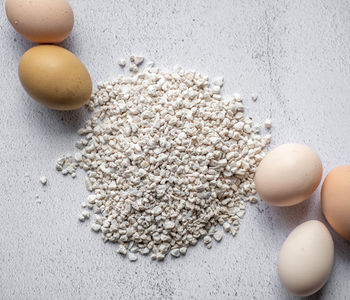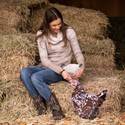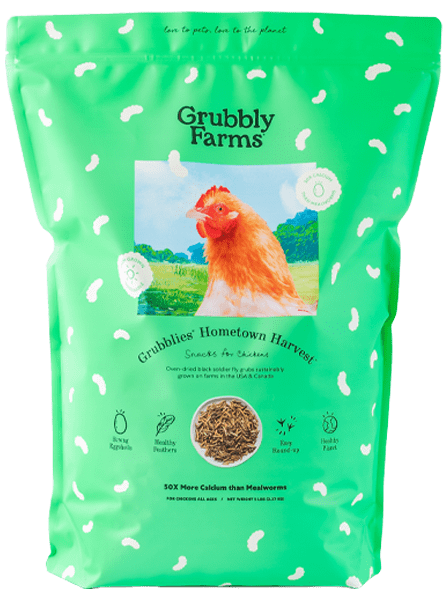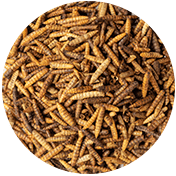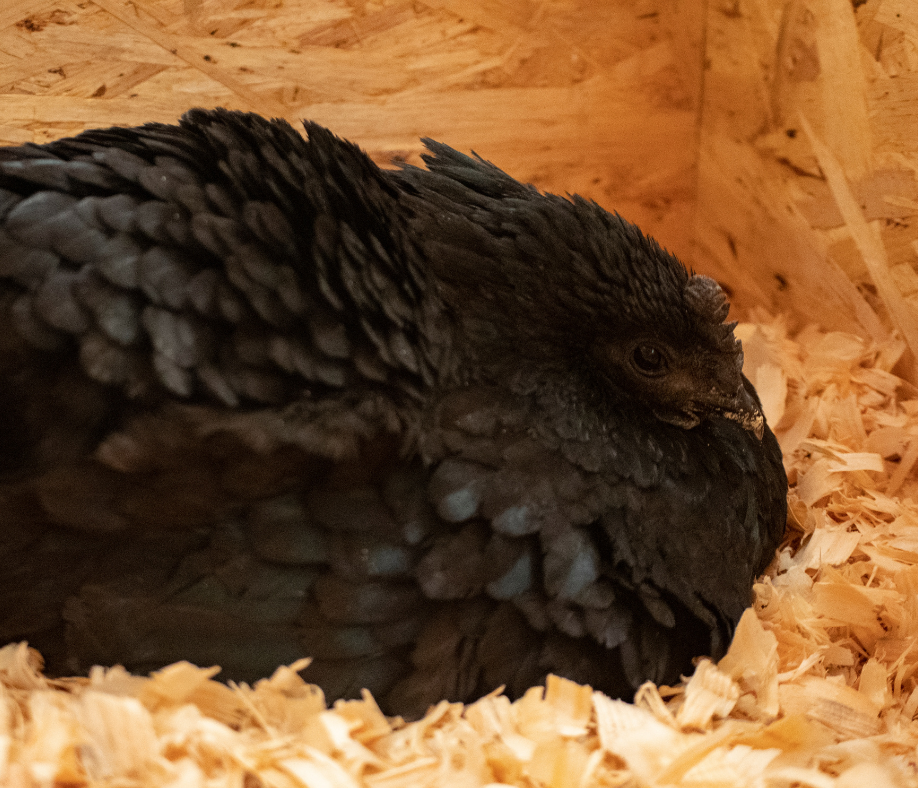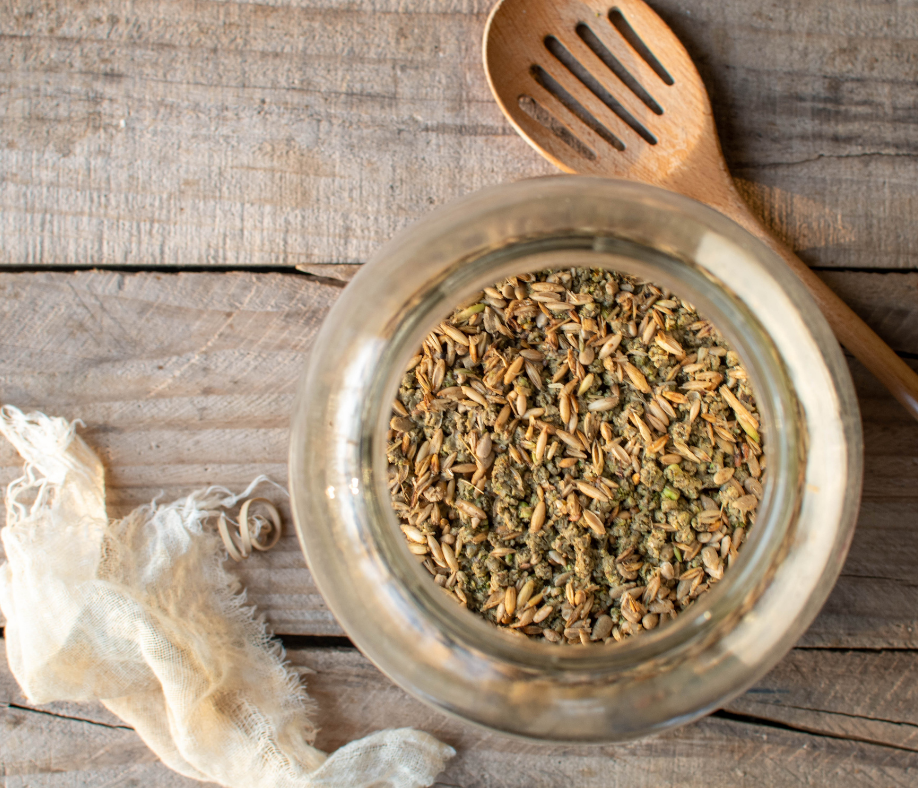What are crushed oyster shells doing in the poultry isle of the feed store? Do you know the significant role that calcium plays in a laying hen’s diet? Did you know that grubs are natural source of calcium for your chickens? If this is all news to you, this article is written for you!
Calcium is an essential nutrient that helps your hens lay well, but it also plays many other roles in keeping your hens healthy. Learning all about calcium, how it functions in the diet, and how to recognize deficiencies and excesses are all important skills to know as a chicken raiser!

Why is Calcium So Important?
An eggshell is made of approximately 90% calcium, which is one of the reasons why calcium is so important in a laying hen’s diet. If a hen is laying an egg every other day, she needs a lot of calcium to make a strong, sturdy eggshell every 48 hours. Calcium is also needed throughout the body for various other functions:
- helps control muscle spasms, especially those used while laying an egg
- triggers hormone production for a healthy reproductive system
- essential for breeding hens to lay strong eggs that will hatch into healthy, strong chicks
- helps with blood clotting
- helps maintain a healthy nervous system
- activates enzymes in the digestive system
- ensures proper bone growth and development
- helps the hen’s body maintain a proper pH level
- helps control the heart rate of a hen
- is needed for the absorption and utilization of phosphorus
A hen’s need for calcium goes far beyond just making strong eggshells. A strong presence of calcium in the diet is essential for the health and longevity of the hen!

The Science Behind it All (for the science nerds!)
Simply knowing that calcium is important for our flock is enough for some of us. However, for the wondering minds out there, knowing how it all works is the fun part! If you are one of those chicken raisers who likes to know the “how” behind every “why”, then this section is for you! If not, feel free to scroll for practical tips on incorporating more calcium into your hens diets.
The Formation of Eggshells
Calcium is absorbed from the diet and stored in the medullary cavity of the hen’s bones. When calcium is needed for the formation of an eggshell, it is released from the medullary cavity into the bloodstream. This triggers the kidneys to stop excreting extra calcium and instead to start conserving calcium to replace the calcium released into the bloodstream.
Calcium is then drawn from foods in the diet to replace the used up calcium. Then the ovaries release estrogen which signals to the body to start making more medullary bone to store more calcium.
This constant cycle of calcium usage, absorption, conservation, and bone development occurs on a regular basis. The hen needs to consume enough calcium each day to meet the needs of all the systems in her body as well as to use it for creating an eggshell.
Since calcium is drawn from the bones for eggshell development, it is especially important that a laying hen gets enough calcium so that she can both create eggshells and build new bone.
Calcium and the Twin Nutrients
When calcium is consumed by a hen, her body can’t use it right away. Two other nutrients need to be present at the same time in order for calcium to be utilized by the hen: phosphorus and vitamin D.
Calcium and phosphorus are both needed in order for each one to be metabolized and used by the body. Phosphorus binds to calcium, which means an imbalance in one leads to an imbalance in the other. Much like calcium, phosphorus helps with bone development as well as plays an important role in the digestion of fats and carbohydrates in the diet. Phosphorus also helps keep the body’s pH level balanced, which is essential for warding off disease.
Phosphorus is abundant in the diet since grains are naturally high in phosphorus. However, plant-based phosphorus is not readily available for absorption, thus other sources of phosphorus must be provided (more on that later!).
In order for both calcium and phosphorus to be metabolized, vitamin D must be present. Vitamin D regulates how much calcium is released into the bloodstream for eggshell formation. It regulates the plasma calcium in the blood and determines whether more calcium is released from the medullary cavities of the bones or whether calcium is conserved to replenish the bones.
Vitamin D is a fat soluble vitamin that is stored in the hen’s liver after it has been absorbed from the diet. When vitamin D is needed to help metabolize calcium and phosphorus, the kidneys trigger vitamin D secretion.

How to Supplement Calcium
Now that we’ve got the science out of the way, some important questions remain. If I’m feeding my hens a complete layer feed, do they still need supplemental calcium? What sources of supplemental calcium can I give my hens? Do I need to provide supplemental phosphorus and vitamin D too?
You should provide your laying hens with supplemental calcium no matter what feed you provide. The need for calcium varies for each hen, but it may be higher or lower depending on these factors:
- Age- older hens need more calcium since their medullary bones have been repeatably depleted for longer
- Diet- a diluted diet (such as with too many unhealthy treats) can lead to a higher need for calcium, likewise, an incomplete diet will also result in an increased need for calcium
- Rate of Lay- hens that are good layers and lay regularly will need more calcium than poor layers
- Season- during high production seasons (like the spring), calcium needs will increase
- Weather- warm weather inhibits calcium absorption and this increases the need for more calcium to be consumed
- Disease- ailments that affect the kidneys and liver will increase the need for calcium since phosphorus and vitamin D absorption are inhibited
- Digestive Health- poor digestive health will increase the need for more calcium
Despite the fact that more calcium is included in layer feeds, supplemental calcium should still be provided in case a hen’s calcium need is higher than what is being provided in the feed. Supplemental calcium allows a hen to adjust her calcium consumption based on her needs.

Common Sources of Supplemental Calcium
- Designed calcium supplements- specially designed, highly bioavailable supplements do a great job of supplying calcium to your flock
- Crushed oyster shells- often sold at feed stores next to the layer feed
- Crushed eggshells- dry eggshells, crush them, and feed them back to your hens (Not Recommended as a replacement for oyster shells - *see below)
- Chipped limestone- less common and cannot be absorbed as readily
You can provide free-choice calcium supplements in a separate feeder or treat dispenser for your hens. They will stop by the free-choice calcium feeder periodically throughout the day and consume little particles of calcium as needed.
The particle size of the calcium supplement must be considered. The pieces need to be small enough that they are easy for the hens to consume. However, they also need to be large enough so that they stay in the digestive track for a longer period of time. Particles that are about pea size or slightly larger are the best for providing adequate calcium. The longer the particle stays in the digestive system being broken down, the more calcium can be absorbed from the supplement.
Aragonite or crushed oyster shells are the best option for providing supplemental calcium. They stay in the digestive track the longest, which optimizes calcium absorption.
Crushed eggshells make a good supplement in addition to crushed oyster shells. However, they can’t be fed by themselves since they don’t remain in the digestive track long enough to provide adequate supplemental calcium.
While chipped limestone can work as a supplemental calcium source, it is not highly recommended. It moves through the digestive system too fast and the calcium content can vary depending on the source of the limestone.
What about phosphorus and vitamin D supplements?
Thankfully, most high-quality, complete layer feeds, such as Grubbly Fresh Pecks Layer Feed, contain the appropriate amount of phosphorus and vitamin D needed by laying hens. However, if calcium needs increase, phosphorus and vitamin D needs will increase slightly too. You can provide these healthy snacks during times when supplemental calcium consumption increases:
- Black soldier fly grubs (excellent balanced source of both calcium and phosphorus)
- Soaked and sprouted sunflower seeds
- Meat and fish (*fish may affect the taste of your eggs)
- Eggs
- Broccoli
It is interesting to note that free-range hens are usually able to control their calcium, phosphorus, and vitamin D need better than confined hens. This is because they can forage for foods that provide the right nutrients that the hens need.
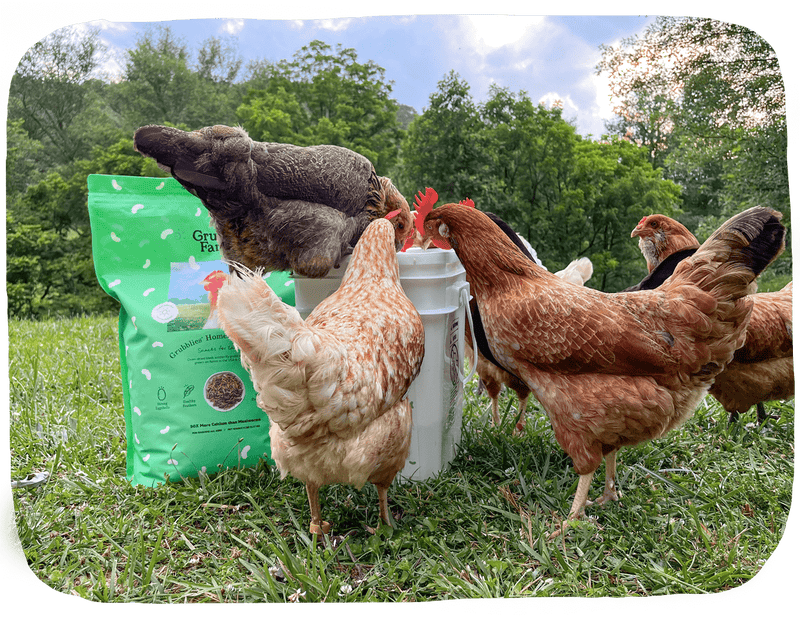
Grubblies
A healthy treat for your flock
With 50x more calcium than mealworms, treat your flock with Grubblies and help support strong eggshells.
Shop NowHow to Spot Calcium Deficiencies
A calcium deficiency will occur when a hen does not, or cannot, consume enough supplemental calcium to meet her needs. Some of the factors that affect the calcium needs of individual hens will also be causes of a calcium deficiency, such as an improper diet, age, environmental factors, and overall health. A deficiency in phosphorus or vitamin D will also cause a calcium deficiency.
Here are some common signs that would indicate a calcium deficiency:
- Thin or soft shells- eggshells are very weak
- Shell-less eggs- the egg contents are just surrounded by the inner and outer membranes without an actual hard shell
- Abnormal skeletal development- more common in developing chicks
- Rickets- a sign of vitamin D deficiency
- Osteoporosis- this occurs when too much calcium is removed from the bones
- Feather loss
- Egg eating- the hens may be eating their own eggs to replace lost calcium
- Egg-binding- remember, calcium is also needed to control egg laying muscle spasms
A calcium deficiency will eventually lead to a stop in laying. A hen’s bones may become fragile, weak, and break easily. A calcium deficiency also weakens a hen’s immune system and makes her more susceptible to disease.
How to Diagnose Excess Calcium
While calcium deficiencies are more common than having too much calcium in the diet, excess calcium can occur when a hen consumes too much supplemental calcium and doesn’t use the excess. There are two signs that indicate varying degrees of too much calcium consumption:
- Deposits on eggshells- calcium deposits on eggshells appear as bumps on the shell, this just means there was slightly too much calcium released into the bloodstream and is usually nothing to worry about
- Hypercalcemia- causes damage to the heart and other organs, is toxic to the liver, and causes the kidneys to calcify (gout), this occurs when there is truly too much calcium in the diet and the hen’s body doesn’t know how to handle it all
By providing supplemental calcium that is free-choice, you are allowing the hens to control their calcium needs. A calcium excess may occur if a hen stops laying but doesn’t stop consuming supplemental calcium. However, you generally don’t have to worry about calcium excesses in the backyard flock.
Guide to Meeting Your Flock’s Calcium Needs

To avoid or help resolve a calcium deficiency in your hens’ diet, you must know how to manage your flock’s calcium needs. While providing free-choice supplemental calcium can help solve and prevent a lot of calcium related issues, knowing how to manage calcium needs under certain circumstances is also important. If you know your flock has a calcium deficiency, you can implement these measures:
- Switch to a better, high-quality complete layer feed.
- Provide supplemental calcium in an easy to access spot. Crushed oyster shells mixed with crushed eggshells are a good option.
- Offer black soldier fly grubs as a healthy snack every day. These protein-packed grubs also contain a balanced amount of both calcium and phosphorus.
Summer months and warm weather can often present an issue in balancing calcium levels for laying hens. When a hen pants, her body’s pH levels increase, which requires more calcium to help rebalance the pH levels. This can present an issue since hens will sometimes eat less during the summer since digestion generates internal heat.
To prevent potential calcium deficiencies, there are a few summer practices you can put into play to help your hens get the calcium they need:
- Add electrolytes to your flock’s water.
- Continue to offer nutrient dense, calcium-rich snacks, like Grubblies.
- Implement measures to keep your hens cool to prevent them from panting.
- Encourage your hens to eat most of their food in the morning or evening, when the temperatures are the coolest. Try sprinkling grubs over the feed to encourage feeding time.
- Ensure your hens are getting a balanced diet: a high-quality layer feed (along with only nutrient-dense and hydrating treats, avoid offering too many table-scraps)
What about chicks? How much calcium do they need?
The amount of calcium growing chicks need is less than what a laying hen requires. Instead, chicks actually need more protein. A chick's protein requirements are higher than what a laying hen needs.
Chicks do not need supplemental calcium since they are not drawing on stored calcium every day to create an eggshell. Their main focus is on growth, and a complete high-quality chick feed will provide them with the proper calcium that they need!
So Much More Than Just Eggshells!

Calcium plays a vital role in the health and productivity of your flock! Not only is it needed for making strong eggshells, but it is also used to support the circulatory system, the nervous system, the cardiac system, and the digestive system of the laying hen. Providing supplemental calcium will allow your hens to manage their own calcium needs and will ensure you are providing all the nutrients your hens need to stay healthy and produce well!
